成都介绍旅游英语英文版
成都旅游介绍英语作文
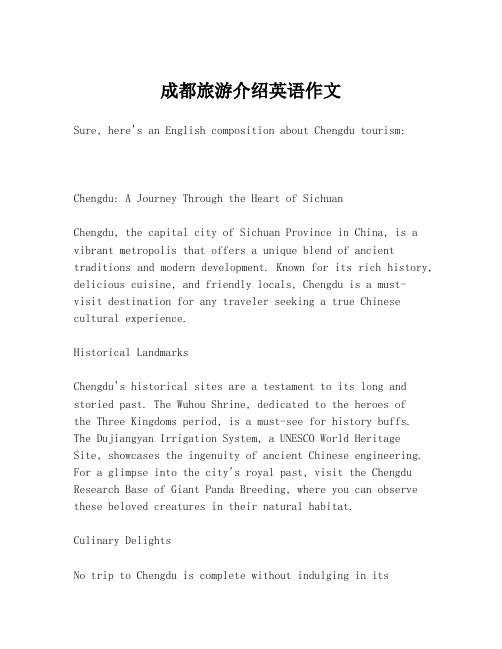
成都旅游介绍英语作文Sure, here's an English composition about Chengdu tourism:Chengdu: A Journey Through the Heart of SichuanChengdu, the capital city of Sichuan Province in China, is a vibrant metropolis that offers a unique blend of ancient traditions and modern development. Known for its rich history, delicious cuisine, and friendly locals, Chengdu is a must-visit destination for any traveler seeking a true Chinese cultural experience.Historical LandmarksChengdu's historical sites are a testament to its long and storied past. The Wuhou Shrine, dedicated to the heroes ofthe Three Kingdoms period, is a must-see for history buffs. The Dujiangyan Irrigation System, a UNESCO World Heritage Site, showcases the ingenuity of ancient Chinese engineering. For a glimpse into the city's royal past, visit the Chengdu Research Base of Giant Panda Breeding, where you can observe these beloved creatures in their natural habitat.Culinary DelightsNo trip to Chengdu is complete without indulging in itsfamous cuisine. Sichuan food is renowned for its bold flavors and spicy kick, with dishes such as Kung Pao Chicken and Mapo Tofu being local favorites. For a more interactive dining experience, visit a hotpot restaurant where you can cook your own food in a shared pot of simmering broth.Cultural ExperiencesThe Jinli Ancient Street is a bustling area where visitorscan shop for traditional handicrafts, watch street performances, and taste a variety of street food. The Chengdu Opera House offers an opportunity to witness the ancient artof Sichuan opera, with its vibrant makeup, elaborate costumes, and dramatic storytelling.Relaxation and LeisureChengdu is also known for its teahouses, where locals gatherto socialize and enjoy a leisurely cup of tea. The People's Park is a great place to relax and observe the daily life of Chengdu residents, from tai chi practitioners to elderly playing mahjong.Shopping and NightlifeFor shopping enthusiasts, the Chunxi Road is a bustling commercial area with a mix of international brands and local boutiques. As the sun sets, the city comes alive with avibrant nightlife. Clubs and bars in areas like Lan Kwai Fong offer a lively atmosphere for a night out.ConclusionChengdu is a city that offers a little bit of everything for the adventurous traveler. Whether you're interested in history, food, culture, or simply relaxing, Chengdu has something to offer everyone. Its warm and welcoming atmosphere makes it a place where visitors can easily feel at home.This composition provides an overview of Chengdu'sattractions and experiences, suitable for an English essay on the topic.。
用英语介绍成都带翻译介绍成都的英语作文参考

用英语介绍成都带翻译介绍成都的英语作文参考篇一:一篇关于成都的英文介绍Chengdu CityChengdu, the capital city of Sichuan province in China, has been recognized as “the land of abundance” for a long time.Withrich cultural heritage, Chengdu is one of the most popular destinations for tourists in China.People who once step onto the land of Chengdu city will quickly fall in love with life there.It seems that Chengdu people are living a happy life with less pressure from their occupation, family or from the conflict social petition.Children,for exle, can enjoy the child-only facilities in the parks.Theycan play with peers and make friends with each other.Forteenagers and adults, the various entertainment places and snack streets are indispensable part of their life.Theold in Chengdu can also sit in a teahouse with a cup of tea after dinner and gossip their family.The pace of life in Chengdu is slower than in other big cities.Peopletend to spend more time and efforts to create and experience happiness.Chengdu is a city where one es and doesn’t want to leave.Thereare many famous scenic spots such as Jingli, Kuanzai Street, Tianfu Square and Chengdu Panda Base.In Chengdu, one can not only enjoy shopping in Tianfu square, walking on the ancient streets and buy souvenirs in traditional houses or stores on Jingli and Kuangzai Street, but also play with cute pandas and help feed their cubs in the Panda Base.Furthermore,watching a Sichuan Opera Show will also provide a newer with unforgettable and precious memories.The delicate face-changing in Sichuan Opera has bee a symbol of Sichuan culture.篇二:成都简介英文版(通俗易懂) Something about my hometown-ChengduHello, everyone, today , I’d like to say something about my hometown ,Chengdu and I sincerely(真诚的) wele you all to e here and have a nice time .Chengdu,the capital of Sichuan Province,lies in the eastern hinterland(内陆) of the Chengdu Plain, in central Sichuan.Covering a total land area of12,400 squarekilometers,Chengdu is divided into nine districts(区), four cities and six counties(县).By the end of20xx,the population of Chengdu had reached10.6 million.This is the basic information you can get to know the moment you get to Chengdu .But what interests us most is the climate(气候), the history and also the life of Chengdupeople .As for the climate , I want to say an idiom(习语)called ShuQuanFeiRi(蜀犬吠日)which means dogs in Chengdu bark(狗叫)at the sun when the sun es out.Thisis because the weather here is always cloudy and wet and people as well as animals here seldom see the sun all year.Basedon this(基于此) , the skins(皮肤)of girls here are pretty good .Sohere es the joke :if you go to Shenzhen, you willfind you are short of money ; if you go to Beijing , you will find your Official position is too low;but if you go to Chengdu , you will find you get married tooearly .Allthesemeans girls here are very pretty as a result of the climate here.(如果你去深圳,你会发现钱太少,去北京,官太小,来成都,你会觉得结婚太早)Secondly ,Chengdu has a long history of more than 3000 years and also is the city whose name hasn’t been changed for a single time in history since it was built as a city .It is said that Kaiming IX,king of ancient Shu in the Zhou Dynasty(11thcentury,about 611BC),started to set up the capital in Chengdu.Thename of Chengdu came from the story of The West-Zhou dynasty.Thestory reads “A town was built in a area in the first year and it will bee the capital in three years,so the ancestors named the city as Chengdu, which implied their hope for this city to bee a capital.西周建都的历史经过,取周王迁岐“一年而所居成聚,二年成邑,三年成都”因此得名成都。
成都的旅游英文介绍作文

成都的旅游英文介绍作文1. Chengdu is a vibrant city in southwest China, known for its delicious Sichuan cuisine and laid-back lifestyle.2. Visitors can explore the historic streets of Jinli Ancient Street, where traditional architecture and local snacks create a charming atmosphere.3. For nature lovers, a visit to the Chengdu Research Base of Giant Panda Breeding is a must-see attraction, where you can see these adorable animals up close.4. Don't forget to experience the lively atmosphere of People's Park, where locals gather to practice tai chi, play mahjong, and enjoy a cup of tea.5. If you're a fan of spicy food, be sure to try the famous Sichuan hotpot, a fiery dish that will surely tantalize your taste buds.6. Chengdu is also a great place to shop for souvenirs, with bustling markets like Wuhou Shrine Market and Wide and Narrow Alley offering a wide variety of local handicrafts and trinkets.7. In the evening, take a stroll along the Jinjiang River and enjoy the beautiful city lights reflected in the water, creating a romantic and picturesque scene.8. Overall, Chengdu is a city that seamlessly blends modernity with tradition, offering visitors a unique and unforgettable travel experience.。
成都景点英文英文介绍作文
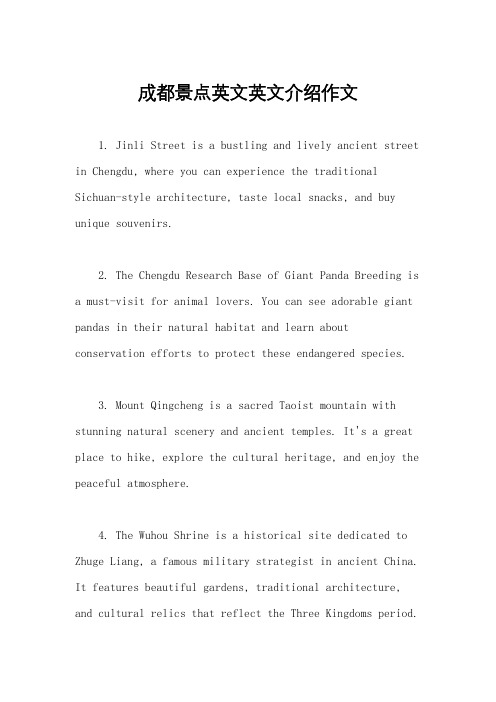
成都景点英文英文介绍作文1. Jinli Street is a bustling and lively ancient street in Chengdu, where you can experience the traditional Sichuan-style architecture, taste local snacks, and buy unique souvenirs.2. The Chengdu Research Base of Giant Panda Breeding isa must-visit for animal lovers. You can see adorable giant pandas in their natural habitat and learn about conservation efforts to protect these endangered species.3. Mount Qingcheng is a sacred Taoist mountain with stunning natural scenery and ancient temples. It's a great place to hike, explore the cultural heritage, and enjoy the peaceful atmosphere.4. The Wuhou Shrine is a historical site dedicated to Zhuge Liang, a famous military strategist in ancient China. It features beautiful gardens, traditional architecture, and cultural relics that reflect the Three Kingdoms period.5. Sichuan Opera is a traditional Chinese opera with unique face-changing performances and acrobatic stunts. The Shu Feng Ya Yun Sichuan Opera House in Chengdu is a great place to watch a live performance and immerse yourself inthe local art and culture.6. The Du Fu Thatched Cottage is a tranquil park and museum that commemorates the famous Tang Dynasty poet Du Fu. It's a peaceful retreat where you can appreciate classical Chinese poetry, explore traditional architecture, and enjoy the beauty of nature.7. The Chengdu Museum showcases the history and culture of Chengdu, featuring a wide range of artifacts, exhibitions, and interactive displays. It's a great placeto learn about the city's rich heritage and ancient civilization.8. The Leshan Giant Buddha is a UNESCO World Heritage site and the largest stone Buddha statue in the world. It's an impressive and awe-inspiring sight, located at theconfluence of the Minjiang, Dadu, and Qingyi rivers.9. The Kuanzhai Alley is a historical and cultural area that preserves the old streets and courtyard houses of Chengdu. It's a charming place to stroll, shop for traditional crafts, and savor the local tea culture.。
成都景点简介英文作文
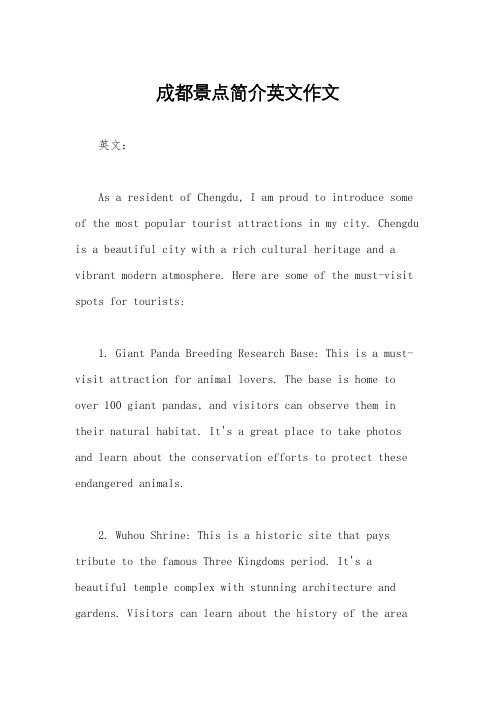
成都景点简介英文作文英文:As a resident of Chengdu, I am proud to introduce some of the most popular tourist attractions in my city. Chengdu is a beautiful city with a rich cultural heritage and a vibrant modern atmosphere. Here are some of the must-visit spots for tourists:1. Giant Panda Breeding Research Base: This is a must-visit attraction for animal lovers. The base is home to over 100 giant pandas, and visitors can observe them in their natural habitat. It's a great place to take photos and learn about the conservation efforts to protect these endangered animals.2. Wuhou Shrine: This is a historic site that pays tribute to the famous Three Kingdoms period. It's a beautiful temple complex with stunning architecture and gardens. Visitors can learn about the history of the areaand enjoy the peaceful atmosphere.3. Jinli Ancient Street: This is a popular shopping and dining destination for both locals and tourists. The street is lined with traditional Chinese buildings and offers a variety of food and souvenir options. It's a great place to experience the local culture and try some Sichuan cuisine.4. Dujiangyan Irrigation System: This is a UNESCO World Heritage Site and one of the oldest irrigation systems in the world. Visitors can explore the ancient system and learn about its history and importance in irrigation technology.5. Sichuan Opera: This is a unique form of Chinese opera that originated in Sichuan province. It's known for its vibrant costumes, acrobatic stunts, and comedic performances. Visitors can enjoy a performance and experience the local culture.中文:作为成都的居民,我很自豪能够介绍一些我城市最受欢迎的旅游景点。
如何介绍成都景点作文英文
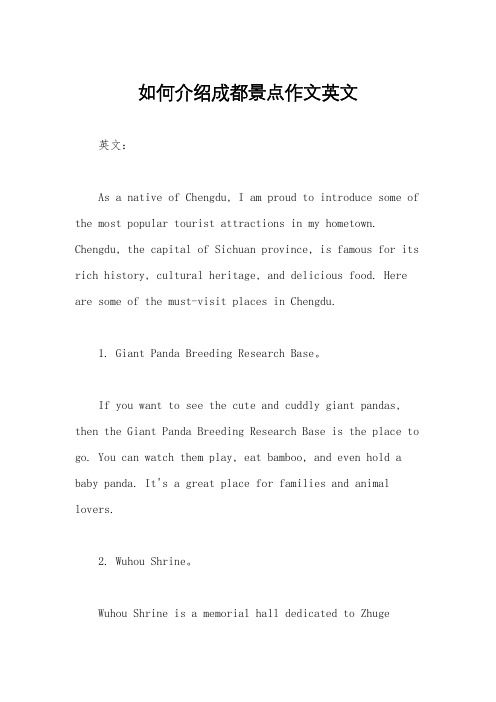
如何介绍成都景点作文英文英文:As a native of Chengdu, I am proud to introduce some of the most popular tourist attractions in my hometown. Chengdu, the capital of Sichuan province, is famous for its rich history, cultural heritage, and delicious food. Here are some of the must-visit places in Chengdu.1. Giant Panda Breeding Research Base。
If you want to see the cute and cuddly giant pandas, then the Giant Panda Breeding Research Base is the place to go. You can watch them play, eat bamboo, and even hold a baby panda. It's a great place for families and animal lovers.2. Wuhou Shrine。
Wuhou Shrine is a memorial hall dedicated to ZhugeLiang, a famous military strategist in the Three Kingdoms period. It's a beautiful place with traditional Chinese architecture and a peaceful atmosphere. You can learn about the history of the Three Kingdoms and admire the ancient artifacts.3. Jinli Ancient Street。
如何介绍成都景点作文英文
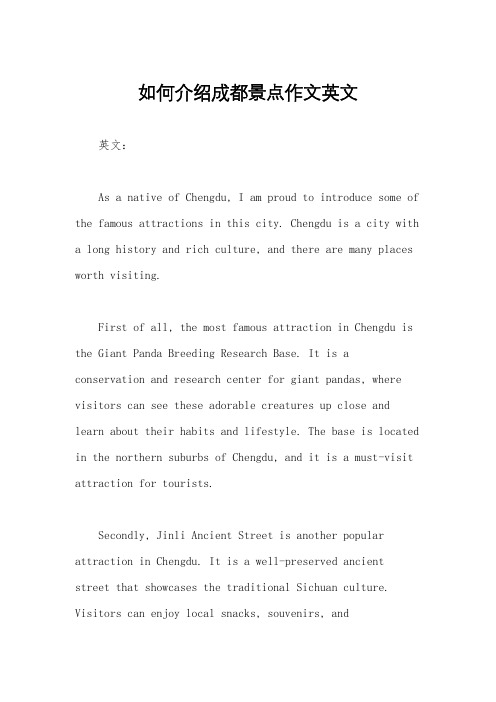
如何介绍成都景点作文英文英文:As a native of Chengdu, I am proud to introduce some of the famous attractions in this city. Chengdu is a city with a long history and rich culture, and there are many places worth visiting.First of all, the most famous attraction in Chengdu is the Giant Panda Breeding Research Base. It is a conservation and research center for giant pandas, where visitors can see these adorable creatures up close and learn about their habits and lifestyle. The base is located in the northern suburbs of Chengdu, and it is a must-visit attraction for tourists.Secondly, Jinli Ancient Street is another popular attraction in Chengdu. It is a well-preserved ancientstreet that showcases the traditional Sichuan culture. Visitors can enjoy local snacks, souvenirs, andperformances while walking along the street. The street is especially beautiful at night when the red lanterns are lit up.Thirdly, Wuhou Shrine is a historical site that honors Zhuge Liang, a famous military strategist in ancient China. The shrine is located in the southern suburbs of Chengduand consists of several temples, gardens, and museums. Visitors can learn about the history of the Three Kingdoms period and appreciate the beautiful architecture and landscapes.In addition to these attractions, Chengdu is also famous for its spicy food, teahouses, and leisurely lifestyle. People in Chengdu enjoy spending time in teahouses, chatting with friends, and playing mahjong. The city is also known for its laid-back atmosphere andfriendly people.中文:作为成都的本地人,我很自豪地介绍一些这个城市的著名景点。
介绍成都游玩景点的英语作文
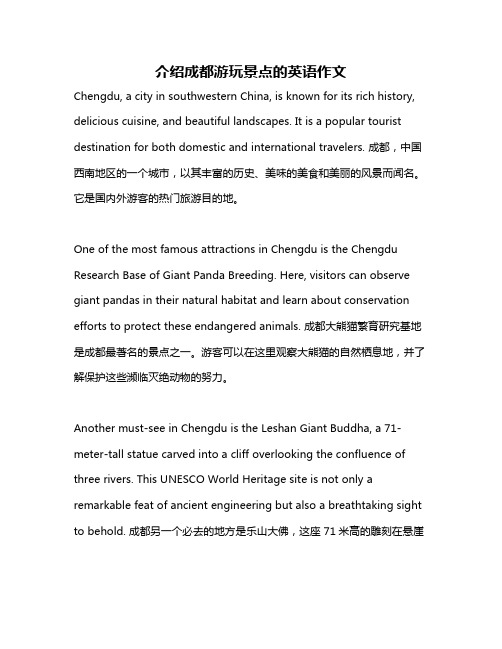
介绍成都游玩景点的英语作文Chengdu, a city in southwestern China, is known for its rich history, delicious cuisine, and beautiful landscapes. It is a popular tourist destination for both domestic and international travelers. 成都,中国西南地区的一个城市,以其丰富的历史、美味的美食和美丽的风景而闻名。
它是国内外游客的热门旅游目的地。
One of the most famous attractions in Chengdu is the Chengdu Research Base of Giant Panda Breeding. Here, visitors can observe giant pandas in their natural habitat and learn about conservation efforts to protect these endangered animals. 成都大熊猫繁育研究基地是成都最著名的景点之一。
游客可以在这里观察大熊猫的自然栖息地,并了解保护这些濒临灭绝动物的努力。
Another must-see in Chengdu is the Leshan Giant Buddha, a 71-meter-tall statue carved into a cliff overlooking the confluence of three rivers. This UNESCO World Heritage site is not only a remarkable feat of ancient engineering but also a breathtaking sight to behold. 成都另一个必去的地方是乐山大佛,这座71米高的雕刻在悬崖上俯瞰三江汇流处的巨大佛像。
- 1、下载文档前请自行甄别文档内容的完整性,平台不提供额外的编辑、内容补充、找答案等附加服务。
- 2、"仅部分预览"的文档,不可在线预览部分如存在完整性等问题,可反馈申请退款(可完整预览的文档不适用该条件!)。
- 3、如文档侵犯您的权益,请联系客服反馈,我们会尽快为您处理(人工客服工作时间:9:00-18:30)。
GENERAL INTRODUCTION
Beijing
Chengdu
Shanghai
Historical Spots
Discovering Chengdu
Chengdu has been designated by the State Council as one of the first of 24 famous historical cities of China.
Sichuan Opera
CULTURE&ENTERTAINMENT
Lifestyle in Chengdu
On a fine day, you can go to a plain tea house, find a bamboo chair, lie on it and enjoy a cup of tea.
HISTORICAL SPOTS
Discovering Chengdu
Culture
& Entertainment
Many celebrities in ancient times left their legends and stories here.
Jinli Street
Jinli is a well-known commercial pedestrian street in Chengdu for the antique building .
Temple of Marquis Wu
Temple of Marquis Wu was built in memory of Zhuge Liang, the famous marquis of the ShuHan Dynasty.
HISTORICAL SPOTS
Zhuge Liang
Zhuge Liang (181 ─ 234), the word Ming, today Shandong Yinan people, the excellence of our history, politicians and military strategists.
SNACKS&CUISINE
Chengdu Snacks
SNACKS&CUNACKS&CUISINE
Hotpot
At present, hotpot is not only a globally recognized symbol of China, it’s also an eye-catching urban landscape that displays the “hotpot complex” of Chengdunese.
CULTURE&ENTERTAINMENT
Lifestyle in Chengdu
Tao Erduo (ear cleaning) is another way of leisure for local people.
CULTURE&ENTERTAINMENT
Snacks & Cuisine
Discovering Chengdu
HISTORICAL SPOTS
Temple of Marquis Wu
HISTORICAL SPOTS
Dujiangyan Irrigation Water System
The Dujiangyan Irrigation Project is known at home and abroad. It was built by Li Bing, a famous expert in irrigation, more than 2,000 years ago.
SNACKS&CUISINE
Hotpot
SNACKS&CUISINE
Welcome to Chengdu
Chengdu cuisine consists of Sichuan food, snack food and hot pot.
Chengdu Snacks
Chengdu Snacks are famous for its tiny and exquisite look, such as “Zhong Dumplings”, “Steamed Dumplings Wrapped in Leaves”, etc.
Discovering Chengdu
“once you come to Chengdu, you do not want to leave”
Origin of the City
Chengdu is the capital of Sichuan Province。
It is seen the center of technology, commerce, trade, finance and transportation in southwestern China。
CULTURE&ENTERTAINMEN
Broad and Narrow Alley
CULTURE&ENTERTAINMEN
Sichuan Opera
Face changing is the highlight of Sichuan Opera, it is a magical art.
CULTURE&ENTERTAINMENT
CULTURE&ENTERTAINMENT
Jinli Street
CULTURE&ENTERTAINMENT
Jinli Street
CULTURE&ENTERTAINMEN
Broad and Narrow Alley
Broad and Narrow Alley is composed of broad alley, narrow alley and across alleys.
